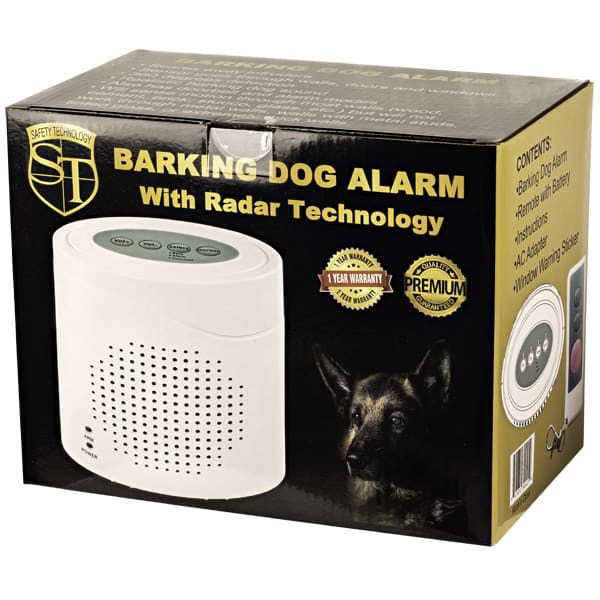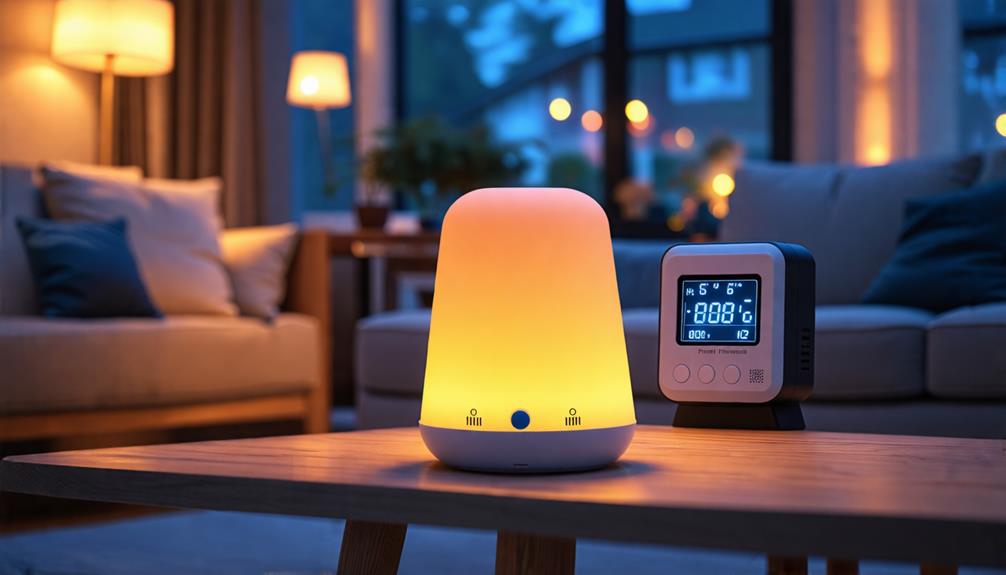
Brainstorm Security Shop

For Orders Over $199

On Any Of Our Products

Details On Refund Page
You’ve likely pondered whether a barking dog alarm is the right fit for your home security needs, especially in terms of energy consumption. While these devices are celebrated for their lower energy use compared to traditional alarm systems, the real impact on your electricity bill depends on several factors. You’ll find that the frequency of the sound, how often the device is triggered, and its sensitivity settings play crucial roles. By considering these elements, you can effectively manage the device’s energy efficiency. But how exactly do these factors interplay, and what can you do to optimize your alarm’s settings? Let’s explore.
Barking dog alarms, a unique security solution, mimic the sound of a barking dog to deter intruders. These devices are crafted to replicate authentic barking behavior, making it seem like a vigilant dog is on the premises, even when you’re not home.
You’ll find these alarms quite versatile, with various settings that can adjust the volume and intensity of the barking based on the level of threat or proximity of a potential intruder.
Different alarm types cater to varying needs. Some models activate only when they detect motion, while others might trigger when they sense vibrations or noises. This flexibility allows you to tailor the security measures to fit your specific situation.
For example, if you live in a busy urban area, you might prefer an alarm that responds more selectively to avoid false alarms triggered by regular pedestrian traffic.
Integrating one of these alarms into your home security setup isn’t just about scaring off would-be burglars; it’s also about giving you peace of mind. Knowing that your home mimics the presence of a protective canine can make you feel safer and more secure, all without the need to care for a real dog.

To kick off your understanding of energy use, you’ll start by learning how to calculate the energy demand of your barking dog alarm.
It’s essential to know this so you can track how much power it uses.
Next, we’ll share some practical efficiency tips to help you reduce consumption and save on your energy bills.
Understanding how much energy your barking dog alarm uses starts with calculating its energy demand. You’ll need to get a grip on a few key energy metrics to make sure you’re not just guessing.
Let’s dive into how you can accurately gauge the power requirements of your device.
First up, check the specifications of your alarm. It’ll give you the wattage, which is a starting point.
Now, think about how long the alarm runs each day. If it’s active for 10 minutes every hour, that adds up to 4 hours in a 24-hour period. Multiply the total hours (4) by the wattage to get the daily consumption in watt-hours.
Next, consider demand forecasting. It’s not just about today’s usage but estimating for the future. This can help you manage costs better, especially if you’re planning to add more alarms or other devices.
Why not boost the efficiency of your barking dog alarm and cut down on energy bills? Let’s dive into some practical tips that’ll help you adjust your device for better performance and energy savings.
Firstly, consider tweaking the alarm sensitivity. By adjusting it, you’re ensuring that the alarm triggers only for appropriate disturbances, avoiding unnecessary activation. This prevents energy wastage and prolongs the life of the device.
Secondly, understanding and managing the barking behavior pattern recognition can also lead to substantial energy savings. Set your alarm to recognize only the specific barking or movement patterns that signify a real threat, rather than every noise or movement around your home.
Here’s a quick guide to help you remember these tips:
| Tip | Benefit |
|---|---|
| Adjust Alarm Sensitivity | Reduces false triggers, saving energy |
| Manage Barking Behavior Recognition | Focuses on real threats, minimizes power use |
Now, let’s compare the barking dog alarm with standard security systems.
You’ll see how it stacks up in terms of energy efficiency, operational costs, and maintenance needs.
Understanding these differences can help you make a more informed decision about which system is right for your home.
When comparing the energy efficiency of barking dog alarms to standard security systems, it’s clear that the former often leads in terms of lower power consumption. You might wonder how these specialized alarms pull ahead. A significant factor is their reliance on advanced sound detection technology. This allows them to remain in a low-energy standby mode until triggered by noise, unlike many traditional systems that continuously use power to monitor a range of sensors.
The barking dog alarm’s design focuses on optimizing battery longevity. This is achieved by integrating energy-efficient components that activate only when necessary. For instance, once the alarm detects a sound that warrants attention, it powers up further functionalities—like emitting loud barking noises to deter intruders.
After addressing the disturbance, the system swiftly returns to its energy-saving mode.
You’ll appreciate knowing that such efficient use of power not only extends the intervals between battery replacements or charges but also reduces the environmental impact associated with high energy consumption.
This strategic approach to energy management ensures that your security system isn’t only effective but also economical in its operation, without the constant energy drain typical of many conventional setups.
Comparing the operational costs of barking dog alarms with standard security systems reveals significant savings. When you conduct a cost analysis, it’s clear that the initial investment in a barking dog alarm is generally lower than that of many comprehensive security systems. This is due, in part, to the simplicity of the design and technology involved.
Moreover, operational efficiency plays a crucial role in driving down costs. Barking dog alarms consume less energy than most traditional systems, which often require multiple components working simultaneously. This lower energy usage directly translates to reduced monthly utility bills. You’re not only saving on the cost of equipment but also on the ongoing expenses.
To put it in perspective, think about the continuous monitoring fees associated with many standard security systems. These fees aren’t a factor with a barking dog alarm, which operates independently without the need for a subscription service.
Additionally, the simplicity of the technology minimizes the risk of costly repairs or upgrades that can be a frequent concern with more complex systems.

Maintaining a barking dog alarm typically requires less effort and cost compared to traditional security systems. You won’t be bogged down with complex maintenance schedules or frequent component replacements. The simplicity of battery care is a standout feature; just check and replace batteries periodically to keep your system running smoothly.
When it comes to system upgrades and troubleshooting tips, you’ll find user feedback particularly useful. This feedback often highlights the ease of handling minor issues yourself, without needing professional help.
Cleaning protocols are straightforward too—regular dusting and keeping the device free from obstructions will do the trick. You should also consider the environmental impacts of your maintenance choices. Opting for rechargeable batteries can minimize waste and enhance the system’s longevity.
Speaking of longevity, implementing longevity strategies like proper storage and avoiding exposure to extreme conditions can extend your alarm’s life significantly. Moreover, keep an eye on warranty considerations. Understanding what’s covered can save you from unexpected costs if a replacement is needed.
Several factors significantly impact the energy consumption of a barking dog alarm.
First off, the sensor technology used can greatly influence how much power is drawn. Advanced sensors that detect motion more accurately might consume more energy, but they also prevent false alarms which can save power in the long run. The type of sound frequency your alarm emits also plays a role; higher frequencies generally require more power.
Your choice of power source matters too. Are you using batteries, or is your alarm connected to the mains? Battery-operated alarms may seem convenient but can lead to frequent replacements if not managed well, affecting both your wallet and the environment.
Usage patterns are another crucial aspect. How often your alarm is triggered can vary widely depending on where you live and your personal security needs. More frequent activations mean higher energy use. Similarly, the alarm duration—how long the alarm sounds once triggered—directly affects consumption.
Lastly, don’t overlook user habits and installation factors. Proper installation away from unnecessary triggers like heavy wind areas can reduce false alarms, saving energy. Plus, your habits, such as regularly checking settings and maintaining the system, play into how efficiently your alarm uses energy.

Understanding the factors that influence your barking dog alarm’s energy consumption sets the stage for implementing effective strategies to enhance its efficiency. Here’s how you can optimize your device.
Firstly, integrate the alarm into your smart home system. System integration allows for better management and often reduces unnecessary energy use. Ensure the alarm technology is up-to-date; newer models tend to be more energy-efficient and offer better sound sensitivity, which can decrease false triggers.
Consider the alarm’s placement carefully. Install the device in a location where it can serve its purpose without being obstructed, which maximizes efficiency and sound detection. Use installation tips from user feedback online to avoid common pitfalls that might lead to excessive energy consumption.
Opt for wireless options if possible. These typically have better battery life and offer more flexibility in placement.
Manage noise control settings to ensure the alarm isn’t overly sensitive, thus avoiding frequent, unnecessary activation.
As the world shifts toward sustainability, eco-friendly innovations in barking dog alarms are making significant strides. You’re seeing a push toward devices that not only protect your home but also respect the environment. Manufacturers are increasingly utilizing sustainable materials in their products. These materials are sourced responsibly and provide durability without depleting natural resources excessively.
Moreover, solar power has become a game-changer for powering these alarms. You can now find barking dog alarms equipped with small solar panels that harness the sun’s energy. This means you’re not just saving on your energy bill, but you’re also reducing your carbon footprint.
The convenience of solar-powered alarms is unmatched as they require minimal maintenance and ensure your home’s security system is running even during power outages.
These innovations reflect a broader trend toward greener, more sustainable home security solutions. By choosing these eco-friendly options, you’re contributing to a larger movement that values environmental preservation alongside personal safety.
Looking ahead, the future of home security alarms promises to integrate even more seamlessly with smart home technology.
You’ll see systems that not only connect with your other devices but also adapt to your lifestyle, learning from your habits to enhance both security and user experience. This means your alarm won’t just alert you—it’ll anticipate and react intelligently to different situations through advanced integration capabilities.
Remote monitoring will become standard, offering you peace of mind wherever you are. You’ll be able to check on your home from your smartphone, receiving real-time updates and even controlling the system remotely. This feature aligns with current market trends that emphasize convenience and connectivity.
Moreover, expect noise sensitivity to improve dramatically. Future alarms will distinguish between everyday sounds and potential threats, reducing false alarms and ensuring a smoother, more reliable operation.
The installation options will also expand, accommodating varying homeowner needs whether you’re tech-savvy or prefer a simpler setup.
As security upgrades continue to evolve, driven by innovations in smart technology, your home won’t only be safer but also smarter.
Keep an eye on these developments—they’re set to redefine what it means to feel secure in your own home.

Yes, you can integrate barking dog alarms with smart home systems.
This integration enhances your home’s security through smart technology integration and automation compatibility. By connecting the alarm to your smart home system, you’ll manage settings remotely and synchronize it with other security features.
It’s ideal for boosting your home’s safety profile while maintaining ease of use. Just ensure your smart system supports this type of integration for seamless operation.
Yes, these alarms are effective in deterring burglars. They exploit the fear of being caught, as the sound of a barking dog suggests someone is home.
Key features include realistic bark sounds that vary in intensity, depending on how close someone is to your property. This unpredictability adds to the illusion, making it a potent tool in burglary prevention.
You’ll find it’s a smart addition to safeguard your home.
To maintain your barking dog alarm, you’ll need to regularly replace the alarm batteries and clean the sensors.
Check the battery life every few months to ensure it’s functioning properly.
For sensor cleaning, gently wipe them with a soft, dry cloth to remove dust or debris.
Avoid harsh cleaners that could damage the sensors.
Staying on top of these tasks will keep your alarm effective and prolong its lifespan.

Yes, barking dog alarms often come with warranties, but the specifics can vary by manufacturer.
You’ll want to check the warranty duration and coverage details before purchasing. Generally, these warranties cover defects in materials and workmanship.
It’s essential to register your product and keep your purchase receipt, as you’ll need these if you ever need to make a claim.
Always read the terms carefully to know what’s included and what isn’t.
Pets often react unpredictably to barking dog alarms at first. Their behavior can vary based on their temperament and alarm familiarity.
Some might become anxious or agitated, hearing another dog’s bark, while others may ignore it completely.
You’ll typically see a period of adjustment, where your pet’s initial confusion or distress fades as they get used to the new noise.
Observing your pet’s reaction carefully will help you understand how they’re coping.
As you consider your home security options, remember that barking dog alarms are not only effective but also energy-efficient. By choosing models with adjustable settings and smart features, you can further reduce your energy use. Embrace these eco-friendly innovations and integrate them with your smart home systems to enhance sustainability. Looking ahead, the future of home security promises even more energy-efficient solutions, ensuring your safety while keeping energy costs low.

Brainstorm Security Shop
1867 Caravan Trail
Ste 105
Jacksonville, FL 32216
Call us toll free: (800) 859-5566